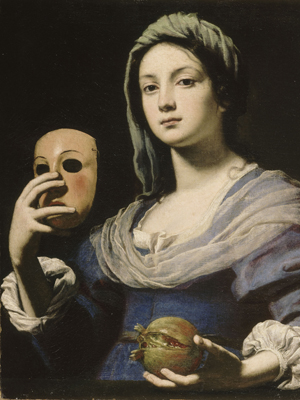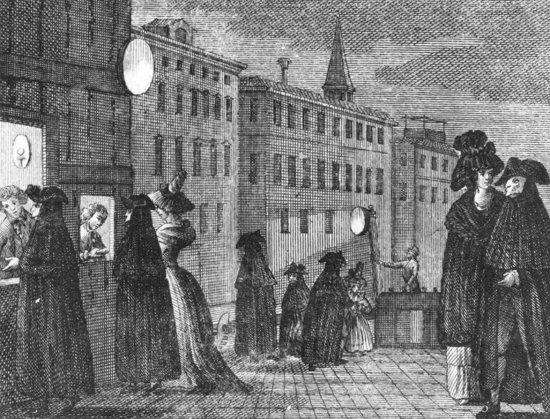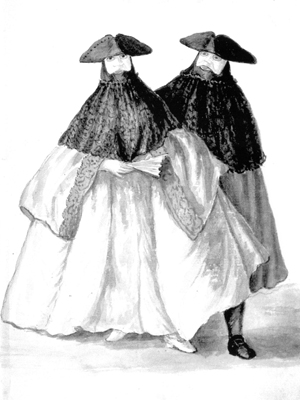Unmasking the Past
CAS prof examines mask-wearing in 18th-century Venice

James Johnson is the kind of historian who wants to get inside people’s heads.
In his 1996 book Listening in Paris: A Cultural History, the College of Arts & Sciences associate professor of history, explored what it was like for people 200 years ago to attend concerts and how they experienced music differently from modern audiences. His newest book, Venice Incognito: Masks in the Serene Republic (University of California Press, 2011), investigates the subject of identity by focusing on the role that masks played in 18th-century Venice.
“As a historian I’m drawn to the inner experience of people who lived centuries ago,” he says. “That’s very elusive to research. You have to generalize from other clues, such as behavior.”
Why focus on mask-wearing as a way to research people’s ideas of self? Johnson, winner of a 1996 Metcalf Award, one of the University’s highest teaching honors, reasoned that uncovering why people disguised themselves in the past might reveal how they thought about identity. As he writes in the preface to Venice Incognito, he was drawn naturally to Venice, where the tradition of masking dates back to the 13th-century. The city’s history of mask-wearing continues today with Carnevale, the annual festival that begins 58 days before Easter and concludes today, Shrove Tuesday, also known as Fat Tuesday, the last day before Lent.
Modern Carnevale revelers don masks largely for celebratory reasons. But as Johnson found through his research, the 18th-century masks themselves, and the reasons people wore them then, bear little resemblance to the feathered, sequined versions you see on partiers parading through the streets of Venice today.
BU Today spoke to Johnson about his research and his book, which recently won the 2011 George Mosse Prize from the American Historical Association.

BU Today: What surprised you most in your research?
Johnson: To learn that Venetians wore masks six months out of the year, from when the theater season started in the fall through Carnevale. Also, they were not wearing masks to disguise themselves or for intrigue or corruption, as people visiting Venice at the time thought. It was a custom, a fashion.
What sparked the fashion?
It’s related to this absolutely hierarchal society. The etiquette was that when you came across a noble and you were a commoner, you had to do these formal, involved salutes. If you have masks on, you don’t have to go through that. That didn’t mean that people were disguised and that they didn’t know each other’s rank, but it’s a token anonymity that allows nobles and commoners to mingle in close quarter in theaters, cafes, and in the street without all this rigmarole. Masks encouraged people to talk who normally wouldn’t have because of their difference in rank. It started with nobles wearing masks to the theater so they could intermingle with commoners there.
So it wasn’t a way of changing one’s identity?
I truly believe that most people in this society couldn’t conceive of being a different person, of rising in society. It wasn’t possible. This way of thinking is very different from how we think of identity today, as something changeable. These masks weren’t about expressing alter egos or people passing themselves off as something they weren’t. This was about greasing the social wheels, even during Carnevale.
What was involved in your research?
Venice in the 18th century was not a particularly literate society, compared to Paris, say, where you can find books and pamphlets on anything. So I spent many hours over the course of six or seven summers going through dusty box after dusty box looking at scraps of paper with mostly illegible handwriting in Italian or Venetian. The richest source came from what was called the State Inquisitors. The government was very paternalistic and thought the morals and habits of the citizens had to be watched. So these agents were sent out to watch the populace. They would submit daily reports, which would include descriptions of people wearing masks.

What did the masks look like?
I think people now would find the masks then very boring. Women wore a moretta, a simple, round black mask that covered their entire face. A woman held it on by gripping a button attached to the inside of the mask with her mouth. That meant she couldn’t speak while in mask.
Men wore a white mask called a bauta, which stuck out below their nose like a beak, making it possible to easily talk or eat. They were held on by lodging them under their tri-corner hats. They were very hot. I plan to wear one to an upcoming Carnevale gala at the Lotos Club in New York City. I found a Venetian in London who sells bautas.
Will it be the first time you’ve worn a mask?
Yes. It’s long overdue.
Comments & Discussion
Boston University moderates comments to facilitate an informed, substantive, civil conversation. Abusive, profane, self-promotional, misleading, incoherent or off-topic comments will be rejected. Moderators are staffed during regular business hours (EST) and can only accept comments written in English. Statistics or facts must include a citation or a link to the citation.